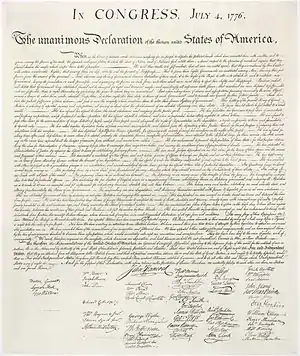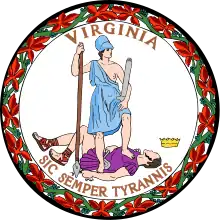Thomas Nelson Jr.
Thomas Nelson Jr. (December 26, 1738 – January 4, 1789) was an American planter, soldier, and statesman from Yorktown, Virginia. In addition to serving in the Virginia General Assembly for many terms, he twice represented Virginia in the Continental Congress and fellow Virginia legislators elected him to serve as the Commonwealth's Governor in 1781. He is one of the U.S. Founding Fathers. He signed the Declaration of Independence as a member of the Virginia delegation, as well as fought in the militia during the Siege of Yorktown.
Thomas Nelson Jr. | |
|---|---|
.jpg.webp) Engraving by H.B. Hall | |
| 4th Governor of Virginia | |
| In office June 12, 1781 – November 22, 1781 | |
| Preceded by | William Fleming (acting) |
| Succeeded by | Benjamin Harrison V |
| Virginia House of Burgesses representing York County | |
| In office 1761–1775 | |
| Preceded by | Robert Carter Nicholas |
| Succeeded by | Corbin Griffin |
| Virginia Ratification Conventions representing York County | |
| In office 1775–1777 Serving with Dudley Digges | |
| Virginia Representative to the Continental Congress | |
| In office 1775–1777 Serving with Carter Braxton, Thomas Jefferson, Francis Lightfoot Lee, Richard Henry Lee, George Washington, George Wythe | |
| Preceded by | Patrick Henry |
| Succeeded by | John Banister |
| Virginia Representative to the Continental Congress | |
| In office 1779–1780 Serving with William Fitzhugh, Thomas Adams, Cyrus Griffin, John Harvie, Arthur Lee, Francis Lightfoot Lee, Richard Henry Lee, James Mercer, Edmund Jennings Randolph, Meriwether Smith | |
| Preceded by | John Banister |
| Succeeded by | James Henry |
| Virginia House of Delegates representing York County | |
| In office May 5, 1777 – June 1781 Serving with Joseph Prentis, William Reynolds | |
| Preceded by | William Digges |
| Succeeded by | unclear |
| Virginia House of Delegates representing York County | |
| In office May 1782 – May 2, 1784 Serving with Joseph Prentis | |
| Preceded by | unclear |
| Succeeded by | Nathaniel Nelson |
| Virginia House of Delegates representing York County | |
| In office October 16, 1786 – June 22, 1788 Serving with Joseph Prentis | |
| Preceded by | Nathaniel Nelson |
| Succeeded by | William Nelson |
| Personal details | |
| Born | December 26, 1738 Yorktown, Colony of Virginia, British America |
| Died | January 4, 1789 (aged 50) Hanover County, Virginia, United States |
| Resting place | Grace Episcopal Churchyard, Yorktown |
| Spouse(s) | Lucy Grymes |
| Relations | Thomas "Scotch Tom" Nelson (grandfather) Robert Carter I (great-grandfather) |
| Children | Hugh Nelson |
| Parents | William Nelson Elizabeth Burwell |
| Alma mater | University of Cambridge |
| Profession | Planter, soldier, statesman |
| Signature | |
Early and family life
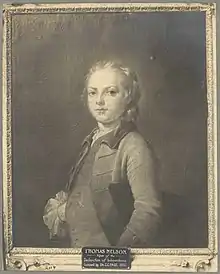
Nelson was the grandson of Thomas "Scotch Tom" Nelson, an immigrant from Cumberland, England, who was an early pioneer at Yorktown. His parents were Elizabeth Carter Burwell (daughter of Robert "King" Carter and widow of Nathaniel Burwell) and William Nelson, who was also a leader of the colony and briefly served as governor. Thomas was born at Yorktown, and like many Virginians of his time, was educated in England. He attended Newcome's School before entering Christ's College at Cambridge University in 1758.[1][2][3] He graduated in 1760 and returned home the following year. In 1762, he married Lucy Grymes (b. August 1743 in Virginia), described as "an uncommon Arithmetician" with a "liberal education" by her daughter. Lucy was the daughter of Hon. Philip Ludwell Grymes and Mary Randolph, of the Randolph family of Virginia.
Planter
Upon returning to Virginia, Nelson assisted his father operate his several plantations, which used enslaved labor. Following his marriage to Lucy Grymes, he also managed the estates left to her sons from her first marriage, including Carter's Grove left to her son Nathaniel Burwell. During the American Revolutionary War, as discussed below, Nelson bought 5400 acres of land and an unspecified number of slaves in Prince William County from financially strapped Lewis Burwell (who died in 1779).[4]
Political career
York County voters first elected this Thomas Nelson to the Virginia House of Burgesses in 1761; he replaced Robert Carter Nicholas in this part-time position and served his first six terms alongside veteran delegate Dudley Digges.[5] As Virginians became dissatisfied with colonial governance, Digges and Nelson were elected to represent York County during the five Virginia Conventions which preceded statehood: the First Virginia Convention (which met in Williamsburg in 1774), the Second Virginia Convention (which met at St. John's Church in Richmond in March 1775), the Third Virginia Convention (which met in Richmond in the summer of 1775), the Fourth Virginia Convention (which met in the winter of 1775-1776 in Richmond and Williamsburg but which Nelson was unable to attend), and the Fifth Virginia Convention which met in Williamsburg in the summer of 1776 (but which Nelson left in May to attend the Continental Congress described below).[6] Digges represented York County alongside Corbin Griffin at the first non-colonial session of the Virginia House of Delegates in the fall of 1776, but Nelson won the 1777 and 1778 elections to represent York County in the House of Delegates and served alongside Joseph Prentis, who relinquished his seat in 1778 to served on the Council of State and was replaced by John Nelson on September 21, 1778[7] In 1779, 1780 and 1781, Nelson served alongside William Reynolds, and relinquished his legislative seat upon being elected governor in June 1781[8]
Nelson's first term in the Congress continued until 1776 when a bout of illness forced his resignation for the 1778-1779 term, although after his recovery, he was again elected and served another year.[9] During his first stint as a member of Congress, Nelson still found time to return home and play a key role in Virginia's Constitutional Convention in the spring of 1776. He returned to Congress in time to sign the Declaration of Independence.
Thomas Nelson was one of the thirteen committee members appointed in the Continental Congress on June 12, 1776, to "prepare and digest the form of confederation" which led to the Articles of Confederation.[10]
He was a Brigadier general[11] of the Lower Virginia Militia, and succeeded Thomas Jefferson as governor of Virginia (after William Fleming's nine days as acting governor). Nelson himself was engaged in the final Siege of Yorktown. According to legend,[12][13] he urged General Washington (or, in some versions, the Marquis de Lafayette) to fire on his own home, the Nelson House, where Cornwallis had his headquarters, offering five guineas to the first man to hit his house.
Following his term as Virginia's governor, Nelson again won election to the Virginia House of Delegates. He represented York County alongside Joseph Prentiss in the Assemblies of 1782 and 1783, but was replaced by Nathaniel Nelson in the Assembly of 1784-1785.[14] He and Joseph Prentiss then won election and again served in the Sessions of 1786-1787 and 1787-1788, but were replaced by Robert Shield and William Nelson in the Assembly of 1788[15]
Death and remembrance
He died at his son's home in Hanover County, Virginia and is buried in the Grace Churchyard at Yorktown. Nelson was a member of Grace Church.
This tribute was paid by Colonel Innes:
The illustrious General Thomas Nelson is no more! He paid the last great debt to nature, on Sunday, the fourth of the present month, at his estate in Hanover. He who undertakes barely to recite the exalted virtues which adorned the life of this great and good man, will unavoidably pronounce a panegyric on human nature. As a man, a citizen, a legislator, and a patriot, he exhibited a conduct untarnished and undebased by sordid or selfish interest, and strongly marked with the genuine characteristics of true religion, sound benevolence, and liberal policy. Entertaining the most ardent love for civil and religious liberty, he was among the first of that glorious band of patriots whose exertions dashed and defeated the machinations of British tyranny, and gave United America freedom and independent empire. At a most important crisis, during the late struggle for American liberty, when this state appeared to be designated as the theatre of action for the contending armies, he was selected by the unanimous suffrage of the legislature to command the virtuous yeomanry of his country; in this honourable employment he remained until the end of the war; as a soldier, he was indefatigably active and coolly intrepid; resolute and undejected in misfortunes, he towered above distress, and struggled with the manifold difficulties to which his situation exposed him, with constancy and courage. In the memorable year 1781, when the whole force of the southern British army was directed to the immediate subjugation of this state, he was called to the helm of government; this was a juncture which indeed 'tried men's souls.' He did not avail himself of this opportunity to retire in the rear of danger; but on the contrary, took the field at the head of his countrymen; and at the hazard of his life, his fame, and individual fortune, by his decision and magnanimity, he saved not only his country, but all America, from disgrace, if not from total ruin. Of this truly patriotic and heroic conduct, the renowned commander in chief, with all the gallant officers of the combined armies employed at the siege of York, will bear ample testimony; this part of his conduct even contemporary jealousy, envy, and malignity were forced to approve, and this, more impartial posterity, if it can believe, will almost adore. If, after contemplating the splendid and heroic parts of his character, we shall inquire for the milder virtues of humanity, and seek for the man, we shall find the refined, beneficent, and social qualities of private life, through all its forms and combinations, so happily modified and united in him, that in the words of the darling poet of nature, it may be said: His life was gentle: and the elements so mixed in him, that nature might stand up And say to all the world—this was a man.[16]
Heritage
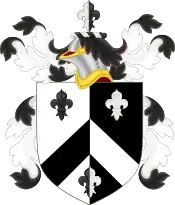
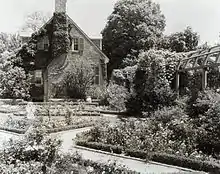
Nelson County, Virginia and Nelson County, Kentucky[17] were named in his honor. The Virginia State Council for Higher Education named Thomas Nelson Community College in Thomas Nelson's honor in 1967. The Nelson County School District, which operates most of the public schools in the Kentucky county, opened the new Thomas Nelson High School in 2012.[18]
An uncle Thomas Nelson (1716–1782) aka "Secretary Nelson" was the father of Captain Thomas Nelson who married Sally Cary (1762–1779) who was a first cousin once removed of Sally Fairfax. Thomas Nelson Jr., the subject of this article, was an ancestor of Thomas Nelson Page and William Nelson Page.
The circa 1730 Nelson House built by "Scotch Tom" Nelson in Yorktown, Virginia, and occupied by Thomas Nelson Jr. during the Revolutionary War is a National Historical Landmark maintained by the Colonial National Historical Park of the U.S. National Park Service.
References
- Brydon, G. Maclaren (1943). "English Education of Thomas Nelson, Jr., of Yorktown". The Virginia Magazine of History and Biography. 51 (4): 347–350. JSTOR 4245255.
- Charles Campbell (1860). History of the Colony and Ancient Dominion. pp. 653–. Retrieved May 13, 2013.
- "Nelson, Thomas (NL758T)". A Cambridge Alumni Database. University of Cambridge.
- Lorena S. Walsh, From Calabar to Carter's Grove: the History of a Virginia Slave Community (University Press of Virginia, 1997) p. 214
- Cynthia Miller Leonard, Virginia General Assembly 1619-1978 (Richmond: Virginia State Library 1978) pp. 93, 96, 98, 101, 104, 107
- Leonard pp. 111, 113, 116, 118, 121
- Leonard pp. 127, 131
- Leonard pp. 135, 139, 143
- Leonard p. xxiii
- "Articles of Confederation Archived 2014-10-26 at the Wayback Machine", History, Park Net, National Park Service, viewed April 20, 2014.
- Smith, John L. (Jr.) (October 21, 2016). "How Yorktown Almost Couldn't Afford To Happen". Journal of the American Revolution. Retrieved June 22, 2020.
- snopes (December 9, 2015). "The Price They Paid". snopes.
- "U.S. National Park Service page on the Nelson House". Retrieved November 21, 2018.
- Leonard p. 147, 151
- Leonard pp., 162, 166
- Charles Augustus Goodrich (1837). Lives of the signers to the Declaration of independence. T. Mather. pp. 410–414.
- The Register of the Kentucky State Historical Society, Volume 1. Kentucky State Historical Society. 1903. p. 36.
- "Our Schools: Thomas Nelson High School". Nelson County School District. Archived from the original on April 25, 2012. Retrieved October 9, 2011.
Further reading
- Emory Evans; Thomas Nelson of Yorktown: Revolutionary Virginian; 1975, University of Virginia; ISBN 0-87935-024-5.
External links
| Wikimedia Commons has media related to Thomas Nelson. |
- United States Congress. "Thomas Nelson Jr. (id: N000044)". Biographical Directory of the United States Congress.
- Biography by Rev. Charles A. Goodrich, 1856
Archival Records
- A Guide to the Executive Papers of Governor Thomas Nelson Jr., 1781 June 12 – November 22 at The Library of Virginia
| Political offices | ||
|---|---|---|
| Preceded by William Fleming |
Governor of Virginia 1781 |
Succeeded by Benjamin Harrison V |
